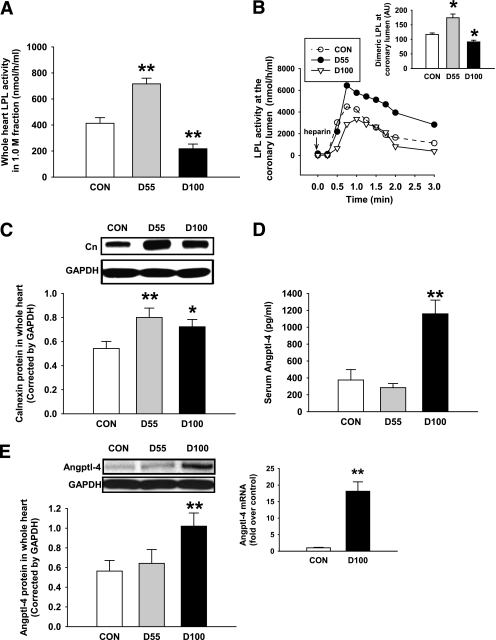FIG. 5.
Severe diabetes reduces LPL dimers with an increase in Angptl-4. Animals were made moderately or severely diabetic by injecting STZ at a dose of 55 (D55) or 100 mg/kg (D100), respectively, and kept for 4 days. Hearts were isolated and equal amounts of homogenate protein from control (CON), D55, and D100 were loaded onto a heparin–sepharose column and eluted with increasing concentrations of NaCl. LPL activity in the 1.0 mol/L fractions was measured, and peak activity presented as mean ± SE of five animals in each group (A). In a separate experiment, hearts from CON, D55, and D100 were perfused with heparin (5 units/mL), perfusates were collected at the indicated times, and LPL activity was determined (B, representative graph). These perfusates at the indicated times were pooled and loaded onto a heparin–sepharose column. Dimeric LPL in the 1.0 mol/L fractions was determined using TCA precipitation followed by Western blot (B, inset). Results are the mean ± SE of three animals in each group. *Significantly different from control, P < 0.05. Heart homogenates from CON, D55, and D100 were also used for Western blot to detect calnexin (Cn) (C) or Angptl-4 (E) protein expressions normalized by GAPDH. Serum samples were collected from the different groups to detect Angptl-4 using an ELISA assay (D). Angptl-4 mRNA expression from CON and D100 hearts was analyzed by real-time quantitative PCR. Gene expression was evaluated by normalizing to 18S-ribosomal RNA and plotted as fold over control (E, inset). Results are the mean ± SE of five animals in each group. *Significantly different from control, P < 0.05. **Significantly different from control, P < 0.01.

